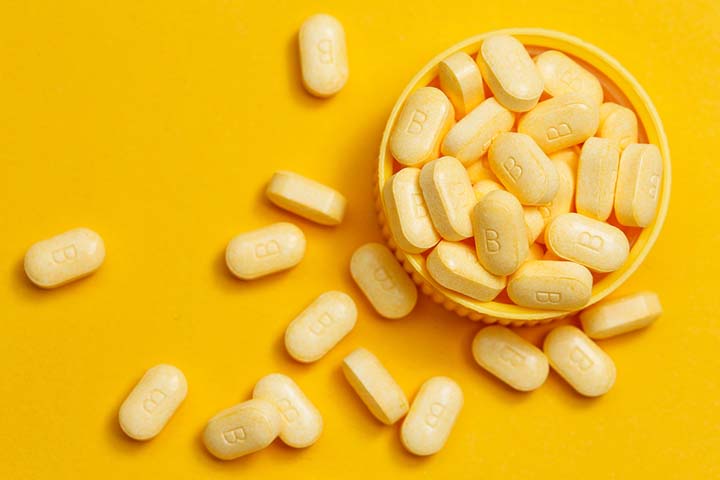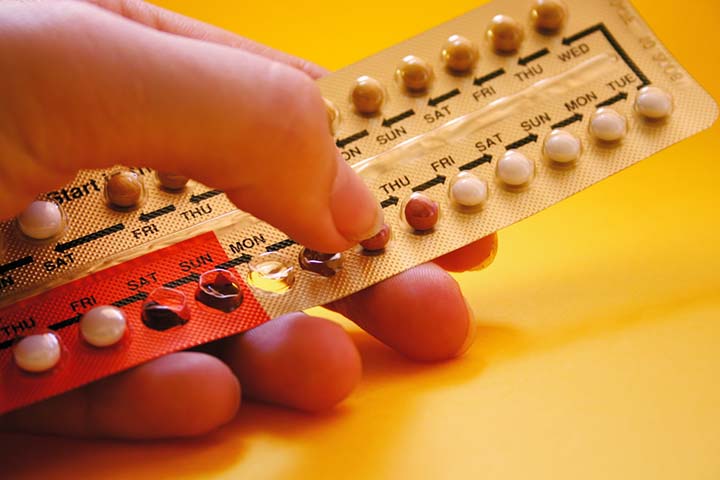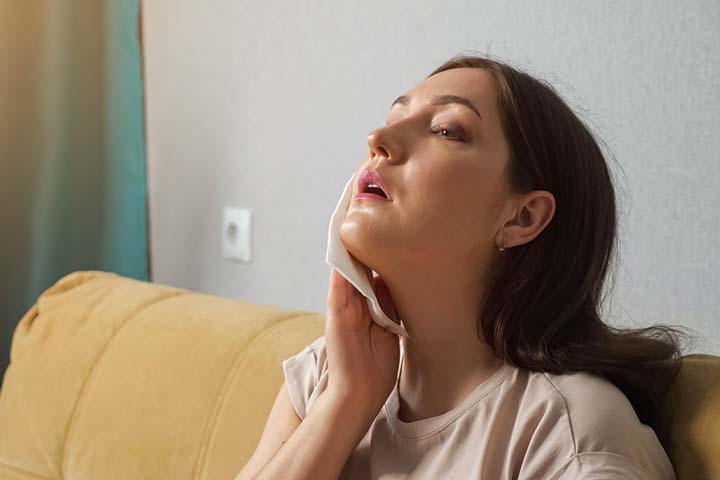Most mothers may look for ways to dry up breast milk due to excess milk production and less need for breast milk after weaning the baby. Though breast milk can be fed to babies for up to two years, some mothers may consider stopping it before the breast milk is dried up due to personal or medical reasons. Early drying up is recommended if there are any health issues related to breastfeeding in the mother or baby.
Cessation of feeding or pumping can lead to breast engorgement and mastitisiXAn infection of the breast tissue leading to swelling, redness, warmth, pain, and extreme sensitivity. in nursing moms. Hence, it is recommended to dry up breast milk as per a lactation consultant’s recommendations.
Read on to know the reasons to dry up breast milk, the ways to do it, and the risks involved in this process.
Why Might A Mother Dry Up Breast Milk?
A breastfeeding mother may consider drying up breast milk due to the following reasons (1) (2).
- The mother does not wish to breastfeed due to personal reasons.
- The mother cannot breastfeed due to medical reasons.
- The breasts have not stopped milk production despite the infant being weaned.
- Oversupply of breast milk, also known as maternal hypergalactia or hyperlactation. This condition could lead to breast engorgement, clogged ductsiXA condition where the milk duct gets blocked, leading to lumps, swelling, itching, and soreness., and infections such as mastitis (3).
- The baby has abruptly stopped breastfeeding or cannot breastfeed for some other reasons.
Despite the reason to stop breastfeeding, it is best to consult a lactation expert to decide a suitable approach to dry up breast milk.
How Long Does It Take For Breast Milk To Dry Up?
Some mothers may find themselves pondering the question, ‘How long does it take for milk to dry up?’ To answer that, it typically takes several weeks to months for milk to completely dry up. The time to dry up breast milk could depend on how long you have been breastfeeding, your current milk supply, and the method used for lactation suppression.
In some cases, even after cessation of milk supply, breasts may produce some milk occasionally. If your breast milk doesn’t dry up or suddenly secretes after a long gap, consult your healthcare provider to determine the possible causes.
Methods To Dry Up Breast Milk
Non-medical methods
These methods may work for some mothers. Consult a lactation expert or doctor before choosing a method.
1. Cold turkey
You can observe a gradual cessation of breastfeeding to slowly reduce breast milk supply and eventually dry up breast milk. It’s essential to wean your baby off breastfeeding gradually. Sudden weaning may make breasts painfully engorged and may increase the risk of breast infection (mastitis) (4). You may prevent these effects by wearing a supportive bra, using ice packs, and expressing breast milk with hands occasionally (5) (1).
2. Cabbage
Research shows topical application of cabbage leaves on the breast may help reduce breast pain and relieve engorgement (6). However, its role in suppressing breast milk still needs more research. You can wear washed and dried, cold cabbage leaves inside the bra and change them every two hours. Continue use until the breasts stop feeling too full (1).
3. Herbs
In traditional medicine, the consumption of sage tea and sage leaf extracts is recommended to reduce milk supply. The topical application of jasmine flowers and oral consumption of chasteberry reduce the prolactiniXA hormone that manages breast tissue development and milk production in mammals. levels in the body and thus minimize milk supply (7).
4. Vitamin B
A few studies note that vitamin B1, B6, and B12 could suppress breast milk supply (8). For instance, vitamin B6 may block milk lactation by suppressing the prolactin levels in nursing mothers (9). However, clinical data supporting these effects are inconsistent and insufficient (10).
5. Binding
Breast binding is an age-old technique to cease breast milk production. However, this method doesn’t prove to be any more effective in drying up milk than other methods. Moreover, breast binding may increase breast pain due to breast engorgement.
Some other non-medical methods that may reduce breast milk secretion are decreasing breastfeeding or pumping, avoiding hot showers, and preventing massaging and stimulating the breasts.
Mary Barfield, a mom of two, says, “I had to stop my breastfeeding journey around the four-month mark because I had to go on a thyroid medication which is proven to pass into breastmilk. My pediatrician wasn’t comfortable with me breastfeeding my daughter with this medication in my breast milk. Things I used to dry up my breast milk are an electric pump, Burress pads, sudafed (a nasal decongestant), peppermint oil diluted with coconut oil, and cabbage leaves (ⅰ).”
6. Cold compress
A cold compress may also help dry up breast milk. First, heat up the breasts to get the milk flowing. A warm shower or heat pad can do this. Then, pump just enough to feel relief and make your breast less full. After you are done with pumping, turn to something cold, like a bag of frozen veggies or an ice pack. This coldness helps to bring down milk production. A balance of heat and cold is key. Make sure you’re comfortable all through, and monitor your milk production so you can tweak your routine if need be (11)
Medical methods
Using medicines to dry up breast milk may have side effects. If you breastfeed occasionally, then the baby could be affected, too. Consult a doctor before trying any medicine for drying breast milk.
6. Sudafed
Pseudoephedrine, sold as Sudafed, is an oral decongestant known to relieve nasal decongestion (12). A study showed that Sudafed suppresses prolactin secretion and reduces breast milk production (13) (14). However, its use during breastfeeding needs a doctor’s consultation.
7. Birth control pills
Consumption of combination oral contraceptives containing estrogen may reduce postpartum breast engorgement by reducing breast milk supply (15) (16). However, the use of contraceptives isn’t suggested for lactation suppression unless advised otherwise by a medical professional.
8. Other medications
Cabergoline is a medication that reduces prolactin levels in the body and reduces breast milk supply. It is commonly used for lactation suppression (5). However, this drug isn’t approved by the FDA. Your doctor may prescribe it under exceptional conditions as the drug’s efficacy and safety are not fully known.
If you experience pain and discomfort due to breast engorgement, you may consider over-the-counter (OTC) anti-inflammatory and analgesic medications after doctor consultation.
Note: The use of bromocriptine for lactation suppression isn’t advisable as it raises the risk of health issues, such as maternal stroke and possibly psychosisiXA mental disorder that may lead to losing contact with reality..
What Are The Possible Risks Of Drying Up Breast Milk?
Ceasing breast milk suddenly may lead to milk duct clogging. It may increase the risk of breast infection called mastitis, a painful condition that often resolves on its own, but if it doesn’t, it may turn severe.
Below are some symptoms that indicate breast infection.
- Painful hard lumps in the breast
- Warm breasts with red streaks
- Chills and fever
- Flu-like symptoms, such as sweating
You can express breast milk to relieve engorgement but keep it less frequent as it may re-stimulate breast milk supply.
An oversupply of breast milk and the inability to breastfeed due to medical or personal reasons are some common reasons drying up breast milk becomes necessary for some mothers. Your current milk supply, how long you have been breastfeeding, and the method of lactation suppression are factors that determine how long it will take to dry up breast milk. Generally, gradually reducing your feeding frequency is the best way to dry up breast milk. However, you could try alternative methods after consulting a doctor.
Key Pointers
- Seek advice from a lactation specialist before deciding on any method to dry up breast milk.
- Placing cold cabbage leaves or ice packs under the bra, a supportive bra, and sage tea are a few non-medical methods that help.
- Certain medications, such as pseudoephedrine and oral contraceptives, can also dry up breast milk.
Learn 7 easy methods to dry up your breast milk quickly and easily! Get the tips you need to stop lactating and get back to your normal routine.















